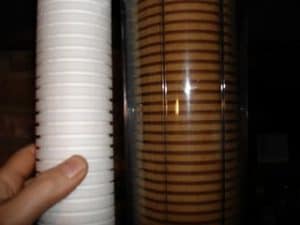For some reason I always seem to end up writing articles about contaminants found in various supplements we ingest, in particular creatine, but there have been others. First I wrote “What’s in your creatine?” which exposed the fact not all creatine supplement are created equal. That article single handedly changed the creatine market at the time. I followed that up with “What’s in your supplements” which was really just a continuation of the first article, with additional testing and comments. I’m calling this one, “What’s in your water?!” for lack of a better title.
I have always been conscious of the potential impurities in drinking water. My town sends out a yearly report on water quality, and has always been well below EPA limits on the chemicals they test for. Regardless, I have always used a water filter to filter my drinking water. (1)
However, until recently, I did not have a basic whole house water filter system. About 6 months ago I installed a in-line water filter system for the entire house. This was not an expensive or fancy unit (2), and is designed to take out soil, silt, sediments, iron, etc, and is rated as a 5 micron filter. It’s not a chemical filter, which means it will not remove chemicals that may find there way into the general water system (e.g., pesticides, lead, PFAS, etc.) but will remove anything 5 microns or above. After 5 months, this was the results:
 A new filter is on the left for comparison. Not very pretty is it? Now, most of that is what the filter is intended to catch, soil, silt, sediments, iron, and miscellaneous crud that gets into any water system. Toxic to human health? In small amounts, probably not. Do you wanna drink the stuff? I don’t, but I can’t speak for you. All I can say is, I was stunned by just how dirty that filter was after 4-5 months of use (they recommend changing this filter every 6 months BTW!) , and I am all the happier I have always at least filtered my drinking water… Regardless of any health issues, all that crud would be normally running through all your water using appliances, so keeping that stuff out of your water heaters, clothes washers (BTW, I swear my clothes are coming out cleaner once I added that filter, but I can’t prove it…) may have some benefits to the appliances. Ever drain your water heater and see all the brown sludge that comes out? That all came from your water supply…
A new filter is on the left for comparison. Not very pretty is it? Now, most of that is what the filter is intended to catch, soil, silt, sediments, iron, and miscellaneous crud that gets into any water system. Toxic to human health? In small amounts, probably not. Do you wanna drink the stuff? I don’t, but I can’t speak for you. All I can say is, I was stunned by just how dirty that filter was after 4-5 months of use (they recommend changing this filter every 6 months BTW!) , and I am all the happier I have always at least filtered my drinking water… Regardless of any health issues, all that crud would be normally running through all your water using appliances, so keeping that stuff out of your water heaters, clothes washers (BTW, I swear my clothes are coming out cleaner once I added that filter, but I can’t prove it…) may have some benefits to the appliances. Ever drain your water heater and see all the brown sludge that comes out? That all came from your water supply…
Not long ago, WebMD did a little investigative journalism and their own testing, matching it up the records in the Atlanta GA area, and found lax testing, record keeping, and other problems, and that was just for lead!
“We reviewed lead testing records obtained through the Open Records Act for water systems in Georgia serving at least 10,000 people. Together, they provide water to about three-quarters of the state’s population. We then compared lead testing addresses to property records for the same locations.
We found a process hindered by poor record keeping and an apparent failure to follow a federal rule that’s been on the books for more than 25 years.”
The full report can be found linked below. (3). Finally, and perhaps most disturbing, we now learned that literally half of the drinking water tested contained what they refer to as “forever chemicals.”
“The synthetic compounds known collectively as PFAS are contaminating drinking water to varying extents in large cities and small towns — and in private wells and public systems, the U.S. Geological Survey said. Researchers described the study as the first nationwide effort to test for PFAS in tap water from private sources in addition to regulated ones. It builds on previous scientific findings that the chemicals are widespread, showing up in consumer products as diverse as nonstick pans, food packaging and water-resistant clothing and making their way into water supplies.” (4)
Map of where they tested, highest concentrations, amounts detected, etc, are found in source #4 below, and worth a read.
Bottom line, don’t rely on local government level testing to assure water quality you’re ingesting, assume some pollution, chemicals, etc made their way into your drinking water, and invest in the best water filtration system you can afford, a quality filter system is worthy investment in reducing your exposure to a wide range of possible contaminants.
(1) Premium 10-Stage Water Filter
(2) Whole House Water Filtration System
(3) Lax Oversight Weakens Lead Testing of Water
(4) Drinking water from nearly half of US faucets contains potentially harmful chemicals, study finds
Will Brink is the owner of the Brinkzone Blog. Will has over 30 years experience as a respected author, columnist and consultant, to the supplement, fitness, bodybuilding, and weight loss industry and has been extensively published. Will graduated from Harvard University with a concentration in the natural sciences, and is a consultant to major supplement, dairy, and pharmaceutical companies.
His often ground breaking articles can be found in publications such as Lets Live, Muscle Media 2000, MuscleMag International, The Life Extension Magazine, Muscle n Fitness, Inside Karate, Exercise For Men Only, Body International, Power, Oxygen, Penthouse, Women’s World and The Townsend Letter For Doctors.
He’s also been published in peer reviewed journals.
Will is the author of the popular e-books, both accompanied by private members forum access , Bodybuilding Revealed & Fat Loss Revealed.
You can also buy Will’s other books on Amazon, Apple iBook, and Barnes and Noble.







Hello Will:
I am new and have a question. I have been dringking a quart of Gaterade during my workout. Would you recomend I continue this? Or not?
Sincerely, Homer
Homes strangely i am also doing this same thing. Care to answer?
Does not have anything to do with the blog topic….but, I can’t answer it off hand. Depends on total calories, goals, temp, water/sweat loss, length and intensity of the exercise, and other variables. We have many people on the forums who throw some whey in Gaterade as a pre and post workout drink, none I can think of drinking it during their workouts. Also see new article on wazy maze about what appears to be an optimal carb source.
Seeing is believing.
Which who;e-house filter did you get?
Basic filter from Lowe’s. See pic and links. Was not expensive or difficult to install. It’s only designed to take out basic crud from your water and is not fully filtering the water. For that, you need a much more extensive filter, which I list above also.
Will, good stuff as always. I’ve a bit to add…
Don’t forget that a lot of folks might want activated carbon in there for chlorine. Certainly don’t want to drink, or shower in and absorb that crud.
Then, there’s the byproducts of chlorine, heavy metals, and so forth that might call for reverse osmosis.
A person really needs to look at the annual analysis from their water company.
Ours included arsenic, lead, haloacetic acid, pesticide residue, and some cadmium along with the sediment and chloramine….
As mentioned article, I use a 10 stage for all drinking water, etc, that’s well past just carbon filtration. Yes, I do read my towns annual water quality report, and we tend to have excellent water. However, remember, there’s plenty of chems simply not tested for.
A lot of things get past most filter arrangements.
We currently run through a sediment and a carbon cartridge for the house for general use, then for drinking a 5 stage reverse osmosis system, with an ion exchange cartridge and a mineralizing cartridge added. Then, that goes into a final trickle filter that is mineral based to improve ph and especially to add a little flavor.
Overkill? Maybe. Then again, if you consume a gallon a day all year, you ingest a lot of contaminants otherwise. I don’t like to think that municipal water usually comes out of the same river the town(s) upstream dumped their sewage in – and their treatment does nothing to remove drugs, hormones, toxins from chemotherapy, possibly some viral agents, and industrial chemicals from what they discharge. Then there’s those cities recycling actual sewage water… A lot of those compounds sail right through most water treatment including most home filtration. If you only have access to this kind of “tap water” then imho why not err on the side of caution?
I’ve been using a 5 stage RODI filter system for years. I bought it mainly for the reef aquarium that I had but it doubles as a drinking water supply. I no longer have an aquarium but I still use the filter to make drinking water. I fill up 5 gallon bottles with the water and I always have a few of those bottles filled on hand, and also a couple of 55 gallon barrels filled just in case.
It’s been a good investment.
After 5 months that is not much dirt especially for a whole house filter. If you were not getting a marked reduction in water flow then the level of contamination must be very low. Looks like a depth filter but most of the comtamination will be on the surface only. Anyhow we probably don’t eat enough dirt. Our ancestors consumed much larger quanties of dirt provideing a good source of mineals. I would be much more conserned about the chemicals and heavy metals in our water supply – the stuff we can’t see.
The stuff we can’t see if removed by the far more extensive filter. Note my very specific language used regarding any risk/harm caused by the dirt and other particles trapped by the basic filter (none was claimed…) and there was a marked reduction in water flow. Personally, no interest in getting my dietary dirt supply from old rusted iron piped in my region.
Does the water in the USA contain Fluoride ?
what is your thoughts on drinking water with this added. Ive read alot of bad stories
Here is in Australia we are drinking Fluoride with a great filter system removing only 70%
Yes, fluoride is often added to drinking water in the US. There’s much controversy over that.
I feel you, What we need is reverse osmosis filter under the sink for at least our drinking water. It is not very cheap unfortunately.
Depends on your viewpoint. Drinking bottled water, a gallon a day per family member, and paying for it at even just $1 a gallon, and paying to transport it, plus the time it takes to haul it – makes the reverse filter look cheap. For two people, it pays for itself in under 90 days. Ongoing maintenance isn’t too bad, either, especially if it runs downstream of a whole house filter. In time, $40 a year maintenance, brings top quality water in under 10 cents a gallon.
I have been designing water and wastewater systems for living for almost 2 decades. I have also been closely involved with public health policy.
Adding a filtration system to your water supply may or may not remove a constituent of concern – and could give others the impression that the water is safer than it actually is.
I don’t drink tap water unless it has gone through an under-sink RO unit. We don’t use a whole house filtration system.
If you are interested in improving the water quality of your domestic water supply, then I recommend consulting with a local expert that understands the problems with your water supply. They generally can prescribe the appropriate processes for a given filtration system.
Hi Will,
Curious if/how this might relate to concerns about the quality and safety of water supplies. I won’t lie I haven’t spent hours nerding out on domestic water purification systems, but I’ve never seen any mention of these types of substances or a product’s ability to remove them. AFAIK municipal wastewater treatment systems aren’t equipped to deal with these types of contaminants…
https://www.ncbi.nlm.nih.gov/pmc/articles/PMC4976290/#:~:text=The%20highest%20concentrations%20of%20pharmaceuticals,%2FL%3B%20Figure%204).